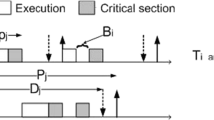Abstract
We describe a methodology that embeds the theory of preemptive Time Petri Nets (pTPN) along development and verification activities of a V-Model lifecycle to support the construction of concurrent real time SW components. Design activities leverage on a pTPN specification of the set of concurrent timed tasks. This supports design validation through simulation and state space analysis, and drives disciplined coding based on conventional primitives of a real-time operating system. In verification activities, the pTPN model comprises an Oracle for unit and integration testing and its symbolic state space supports test case selection, test sensitization and coverage evaluation.
Preview
Unable to display preview. Download preview PDF.
Similar content being viewed by others
References
RTCA (Radio Technical Commission for Aeronautics). Do-178b, software considerations in airborne systems and equipment certification, http://www.rtca.org/
Hessel, A., Larsen, K., Nielsen, B., Pettersson, P., Skou, A.: Time-Optimal Real-Time Test Case Generation Using Uppaal. In: Petrenko, A., Ulrich, A. (eds.) FATES 2003. LNCS, vol. 2931, pp. 114–130. Springer, Heidelberg (2004)
Larsen, K., Mikucionis, M., Nielsen, B.: Online Testing of Real-Time Systems Using UPPAAL: Status and Future Work. Perspectives of Model-Based Testing (2005)
Krichen, M., Tripakis, S.: Black-Box Conformance Testing for Real-Time Systems. In: Graf, S., Mounier, L. (eds.) SPIN 2004. LNCS, vol. 2989, pp. 109–126. Springer, Heidelberg (2004)
Bucci, G., Fedeli, A., Sassoli, L., Vicario, E.: Timed state space analysis of real time preemptive systems. IEEE Trans.on Soft.Eng. 30(2), 97–111 (2004)
Roux, O.H., Lime, D.: Time Petri Nets with Inhibitor Hyperarcs. Formal Semantics and State Space Computation. In: Cortadella, J., Reisig, W. (eds.) ICATPN 2004. LNCS, vol. 3099, pp. 371–390. Springer, Heidelberg (2004)
Larsen, K.G., Cassez, F.: The Impressive Power of Stopwatches. In: Palamidessi, C. (ed.) CONCUR 2000. LNCS, vol. 1877. Springer, Heidelberg (2000)
Bucci, G., Fedeli, A., Sassoli, L., Vicario, E.: Modeling flexible real time systems with preemptive time petri nets. In: Proceedings of the 15th Euromicro Conference on Real-Time Systems (ECRTS 2003) (2003)
Buttazzo, G.: Hard Real-Time Computing Systems. Springer, Heidelberg (2005)
Merlin, P., Farber, D.J.: Recoverability of communication protocols. IEEE Trans.on Communications 24(9) (1976)
Berthomieu, B., Diaz, M.: Modeling and verification of time dependent systems using time petri nets. IEEE Trans. on Soft. Eng. 17(3) (1991)
Penczek, W., Półrola, A.: Specification and Model Checking of Temporal Properties in Time Petri Nets and Timed Automata. In: Cortadella, J., Reisig, W. (eds.) ICATPN 2004. LNCS, vol. 3099, pp. 37–76. Springer, Heidelberg (2004)
Berthomieu, B., Menasche, M.: An enumerative approach for analyzing time Petri nets. In: Information Processing: proc. of the IFIP congress, vol. 9, pp. 41–46 (1983)
Vicario, E.: Static analysis and dynamic steering of time dependent systems using time petri nets. IEEE Trans. on Soft. Eng. (2001)
Berthomieu, B., Lime, D., Roux, O.H., Vernadat, F.: Reachability problems and abstract state spaces for time petri nets with stopwatches. LAAS Report (2004)
Sassoli, L., Vicario, E.: Analysis of real time systems through the oris tool. In: Proc. of the 3rd Int. Conf. on the Quant. Evaluation of Sys. (QEST) (2006)
CENELEC-prEN50128: Railway applications: Sw for railway control and protection systems (1997)
Jard, C., Jéron, T.: Tgv: theory, principles and algorithms, a tool for the automatic synthesis of conformance test cases for non-deterministic reactive systems. Software Tools for Technology Transfer (STTT) 6 (2004)
Carnevali, L., Sassoli, L., Vicario, E.: Sensitization of symbolic runs in real-time testing using the oris tool. In: Proc. of the 12th IEEE Conference on Emerging Technologies and Factory Automation (ETFA) (2007)
Carnevali, L., Sassoli, L., Vicario, E.: Casting preemptive time petri nets in the development life cycle of real-time software. In: Proc. of the 19-th Euromicro Conference on Real-Time Systems (ECRTS) (2007)
IEC 62304 International Standard Edition 1.0 Medical device software - Software life cycle processes (2006)
Developing Standard for IT Systems of the Federal Republic of Germany. Lifecycle Process Model General Directive No. 250. (1997)
Author information
Authors and Affiliations
Editor information
Rights and permissions
Copyright information
© 2008 Springer-Verlag Berlin Heidelberg
About this paper
Cite this paper
Carnevali, L., Grassi, L., Vicario, E. (2008). A Tailored V-Model Exploiting the Theory of Preemptive Time Petri Nets. In: Kordon, F., Vardanega, T. (eds) Reliable Software Technologies – Ada-Europe 2008. Ada-Europe 2008. Lecture Notes in Computer Science, vol 5026. Springer, Berlin, Heidelberg. https://doi.org/10.1007/978-3-540-68624-8_7
Download citation
DOI: https://doi.org/10.1007/978-3-540-68624-8_7
Publisher Name: Springer, Berlin, Heidelberg
Print ISBN: 978-3-540-68621-7
Online ISBN: 978-3-540-68624-8
eBook Packages: Computer ScienceComputer Science (R0)




